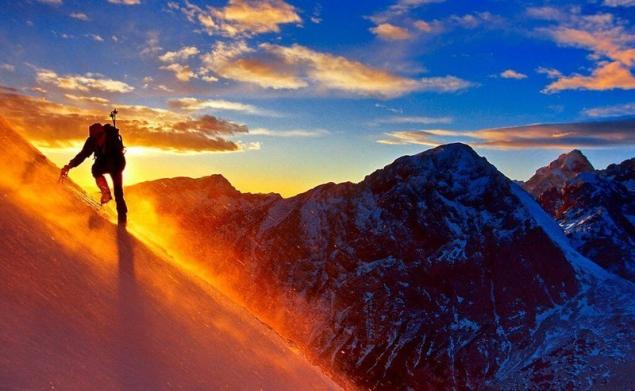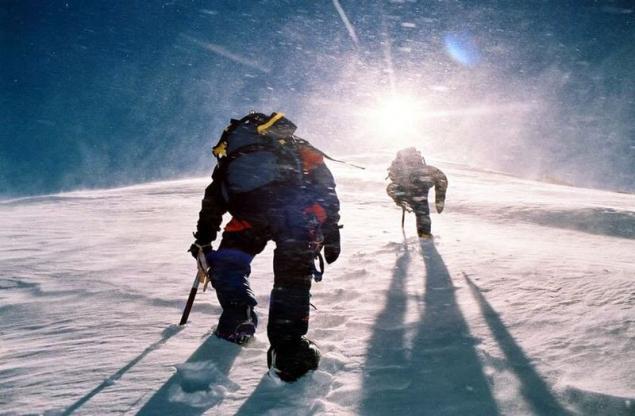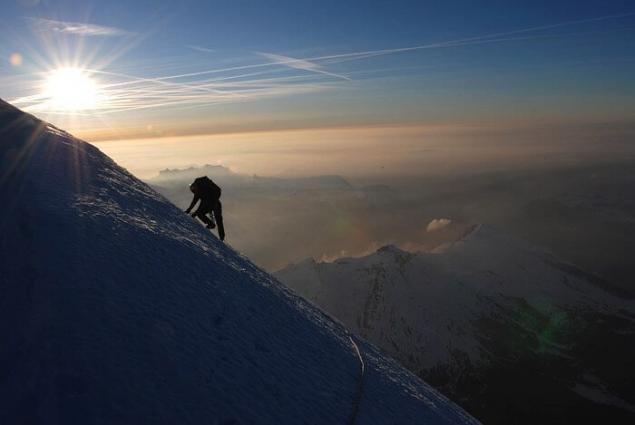458
What happens to a person at the height of 7000 meters
It is critical for a person the height to which the body can not adapt for more than 2-3 days. Physiologists call this the impossibility of complete acclimatization. The higher from this point, the less people can live.
1 Altitude sickness
This is the common name for the different effects of lack of oxygen at altitude. At sea level the air is almost 21 percent oxygen is 100 percent of what is required. While climbing mountains because of lower pressure at an altitude of 7000 meters the level of supply of blood oxygen is 60% of the required funding is critically low level. Because of this, the human body is a complex pathological reactions. For the purposes of assessing high-altitude illness in the international classification adopted by such gradations in altitude: 1500 – 3500 m – high altitude, 3500 – 5500 m –a very great height, more than 5,500 m extreme altitude. So, back to a predetermined height of 7000 m.

2 "Breath like a rat dog"
Is the term high-altitude physiologists used to the inevitable pathology of respiration. It becomes fast and heavy, with shortness of breath. Due to shortness of breath of the climber is retained, only a third of health which he possessed at sea level.
Due to hyperventilation in the blood decreases the level is very important for the work of the internal organs carbon dioxide.
Develops respiratory alkalosis is a disturbance of acid-base balance towards alkaline. Because of this deteriorating blood flow, increases neuromuscular irritability up to seizures, there is a complete loss of appetite, not to mention the dizziness.
During sleep the person suffers from the so-called periodic breathing – sleep apnea, which at the height takes a particularly acute form. Because of this – insomnia, aggravating illness.
3 Mental disorders
Very often at the height of the climbers begin to behave strangely trying to catch a taxi, looking for the bus stop, talking with an imaginary companion. One experienced climber-physician because of the frequent ascensions during the year suffered from hallucination: he was visited by aliens with long blond hair growth 230-240 cm and conversed with him on various topics.
Participant of the first Soviet ascent of Everest Edward Smyslovskiy during the descent, when he ran out of oxygen, he refused to go and demanded to leave him in the mountains. All this, according to doctors, symptoms of hypoxic cerebrovascular insufficiency.

4 pulmonary Edema
Experienced climbers are advised to acclimatize to do light exercise, stimulating blood flow in the pulmonary circulation. The fact that stasis there is one of the important pathologies that contribute to pulmonary edema. Swelling inevitably begins to develop about the third day at a given height of 7000 m. in simple terms, pulmonary edema is when fluid from your blood pressure went from small vessels and fills the lungs. This is the most common cause of death in the mountains – are due to pathological causes, not fall, avalanches and so on.
5 cerebral Edema
Happens for the same reason – because of the fluid accumulation of blood, leaving the capillaries in the brain. In extreme stages dehydrated tissue of the cerebellum is cut into the trunk of the spinal cord. Death.
Cerebral edema rarely develops pulmonary edema, more evident. At the initial stage is headaches, noise in the head, constant vomiting, a condition similar to extreme drunkenness. Person is difficult, can not connect words, etc.

6 is the Use of height
Of course, one seeks in the mountains, not only in order to suffer, and the highlanders, long live not from altitude sickness. There are many processes in the body that improve, and dramatically, thanks to the adaptation to extreme high-altitude conditions. Growing network of cerebral, cardiac and pulmonary capillaries – they are important for the supply of internal organs with nutrients from the blood.
Increases the number of enzymes responsible for the synthesis of neurotransmitters and hormones, and tissues increasing the number of receptors. Roughly speaking, one becomes smarter and stronger.
Increasing the production of myoglobin – a substance that is more effective hemoglobin delivers oxygen to hard to reach places in the body. Sharply reduced the number of pathogenic substances, cholesterol, etc. Dramatically reduces aterogennoe blood, which reflects the tendency to cardiovascular disease.
In the end, according to the climbers, for many months after a serious climbing there is a feeling of lightness and flight. published
P. S. And remember, only by changing their consumption — together we change the world! © Join us at Facebook , Vkontakte, Odnoklassniki
Source: vk.com/gnezdo_paranoika?w=wall-38598449_114176
1 Altitude sickness
This is the common name for the different effects of lack of oxygen at altitude. At sea level the air is almost 21 percent oxygen is 100 percent of what is required. While climbing mountains because of lower pressure at an altitude of 7000 meters the level of supply of blood oxygen is 60% of the required funding is critically low level. Because of this, the human body is a complex pathological reactions. For the purposes of assessing high-altitude illness in the international classification adopted by such gradations in altitude: 1500 – 3500 m – high altitude, 3500 – 5500 m –a very great height, more than 5,500 m extreme altitude. So, back to a predetermined height of 7000 m.

2 "Breath like a rat dog"
Is the term high-altitude physiologists used to the inevitable pathology of respiration. It becomes fast and heavy, with shortness of breath. Due to shortness of breath of the climber is retained, only a third of health which he possessed at sea level.
Due to hyperventilation in the blood decreases the level is very important for the work of the internal organs carbon dioxide.
Develops respiratory alkalosis is a disturbance of acid-base balance towards alkaline. Because of this deteriorating blood flow, increases neuromuscular irritability up to seizures, there is a complete loss of appetite, not to mention the dizziness.
During sleep the person suffers from the so-called periodic breathing – sleep apnea, which at the height takes a particularly acute form. Because of this – insomnia, aggravating illness.
3 Mental disorders
Very often at the height of the climbers begin to behave strangely trying to catch a taxi, looking for the bus stop, talking with an imaginary companion. One experienced climber-physician because of the frequent ascensions during the year suffered from hallucination: he was visited by aliens with long blond hair growth 230-240 cm and conversed with him on various topics.
Participant of the first Soviet ascent of Everest Edward Smyslovskiy during the descent, when he ran out of oxygen, he refused to go and demanded to leave him in the mountains. All this, according to doctors, symptoms of hypoxic cerebrovascular insufficiency.

4 pulmonary Edema
Experienced climbers are advised to acclimatize to do light exercise, stimulating blood flow in the pulmonary circulation. The fact that stasis there is one of the important pathologies that contribute to pulmonary edema. Swelling inevitably begins to develop about the third day at a given height of 7000 m. in simple terms, pulmonary edema is when fluid from your blood pressure went from small vessels and fills the lungs. This is the most common cause of death in the mountains – are due to pathological causes, not fall, avalanches and so on.
5 cerebral Edema
Happens for the same reason – because of the fluid accumulation of blood, leaving the capillaries in the brain. In extreme stages dehydrated tissue of the cerebellum is cut into the trunk of the spinal cord. Death.
Cerebral edema rarely develops pulmonary edema, more evident. At the initial stage is headaches, noise in the head, constant vomiting, a condition similar to extreme drunkenness. Person is difficult, can not connect words, etc.

6 is the Use of height
Of course, one seeks in the mountains, not only in order to suffer, and the highlanders, long live not from altitude sickness. There are many processes in the body that improve, and dramatically, thanks to the adaptation to extreme high-altitude conditions. Growing network of cerebral, cardiac and pulmonary capillaries – they are important for the supply of internal organs with nutrients from the blood.
Increases the number of enzymes responsible for the synthesis of neurotransmitters and hormones, and tissues increasing the number of receptors. Roughly speaking, one becomes smarter and stronger.
Increasing the production of myoglobin – a substance that is more effective hemoglobin delivers oxygen to hard to reach places in the body. Sharply reduced the number of pathogenic substances, cholesterol, etc. Dramatically reduces aterogennoe blood, which reflects the tendency to cardiovascular disease.
In the end, according to the climbers, for many months after a serious climbing there is a feeling of lightness and flight. published
P. S. And remember, only by changing their consumption — together we change the world! © Join us at Facebook , Vkontakte, Odnoklassniki
Source: vk.com/gnezdo_paranoika?w=wall-38598449_114176
What you need for a good life—3 MAIN LESSON
When the distortion of reality and self-deception — a sign of a healthy person























